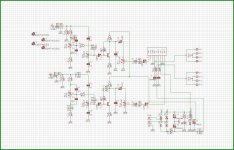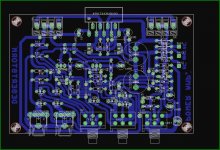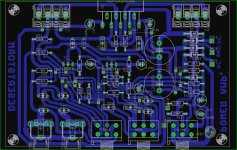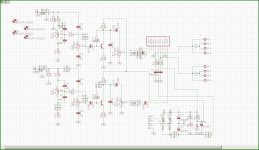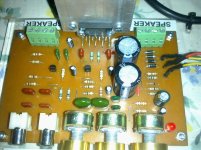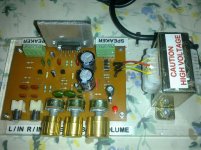Pls. somebody can help me how to eliminate hum.sound in my amp.
thank you so much in advance merry x mas to all diyers...
here is the final layout of my amp.
thank you so much for all of your suggestions.
god bless and more power to all....merry Christmas to all of you...
thank you so much in advance merry x mas to all diyers...
here is the final layout of my amp.
thank you so much for all of your suggestions.
god bless and more power to all....merry Christmas to all of you...
Attachments
Last edited:
You schematic diagram is still too small to read even if expanded.
One usually removes hum by 1. making sure the high gain sections of an amp are separated from the power transformer and rectifier areas by distance, or a steel bulkhead or other metal perhaps, bulkhead. Some devices have the power transformer in a steel shell. More modern in this power class is to use a wall transformer as a power source, keeping the transformer out of the gain enclosure entirely.
2. Avoid parallel runs of high gain input wiring, and 120 VAC wiring.
3. Making sure the device is enclosed in a grounded metal enclosure, especially the high gain portions.
4. Making sure input wires that might pick up hum from the house wiring, are either twisted pair, or shielded coax cable, as the kind that comes with RCA plugs on the end.
5. Making sure the power supply has sufficient capacitance or other means to reduce ripple in the dc supplies to acceptable levels.
6. If power supplies still have ripple, many designs use constant current sources in series with the high gain transistors to reduce the effect of ripple on the resulting signal. Read the construction document in the sticky thread of the "honey badger" amp to see which transistors are the constant current source ones. I don't believe your amp has any of these devices.
For a fully worked out solution, you may buy honey badger circuit boards from diyaudio warehouses on various continents. If you like lower wattage, you can delete one pair of output devices, and probably can reduce the power supply voltage pair also.
You may also use a single voltage wall transformer with the "50 watt retro amp" which is detailed in a thread of the same name. http://www.diyaudio.com/forums/solid-state/242916-retro-amplifier-50-watt-circuit.html This is a single supply amp. I find 32 VDC wall transformers for printer/copier/fax machines to be intriguing devices for single supply amp projects, as they put out about 3 amps. I can buy them without the copier for $2 at the Salvation Army resale shop near me.
Good luck.
One usually removes hum by 1. making sure the high gain sections of an amp are separated from the power transformer and rectifier areas by distance, or a steel bulkhead or other metal perhaps, bulkhead. Some devices have the power transformer in a steel shell. More modern in this power class is to use a wall transformer as a power source, keeping the transformer out of the gain enclosure entirely.
2. Avoid parallel runs of high gain input wiring, and 120 VAC wiring.
3. Making sure the device is enclosed in a grounded metal enclosure, especially the high gain portions.
4. Making sure input wires that might pick up hum from the house wiring, are either twisted pair, or shielded coax cable, as the kind that comes with RCA plugs on the end.
5. Making sure the power supply has sufficient capacitance or other means to reduce ripple in the dc supplies to acceptable levels.
6. If power supplies still have ripple, many designs use constant current sources in series with the high gain transistors to reduce the effect of ripple on the resulting signal. Read the construction document in the sticky thread of the "honey badger" amp to see which transistors are the constant current source ones. I don't believe your amp has any of these devices.
For a fully worked out solution, you may buy honey badger circuit boards from diyaudio warehouses on various continents. If you like lower wattage, you can delete one pair of output devices, and probably can reduce the power supply voltage pair also.
You may also use a single voltage wall transformer with the "50 watt retro amp" which is detailed in a thread of the same name. http://www.diyaudio.com/forums/solid-state/242916-retro-amplifier-50-watt-circuit.html This is a single supply amp. I find 32 VDC wall transformers for printer/copier/fax machines to be intriguing devices for single supply amp projects, as they put out about 3 amps. I can buy them without the copier for $2 at the Salvation Army resale shop near me.
Good luck.
Last edited:
Grounding should be star coupled or a plane ..... use a double sided pcb and use one side for GND .... can be had in China for very little money .... e.g. ITEAD Studio 2Layer Green PCB 5cm x 10cm Max
Pls. somebody can help me how to eliminate hum.sound in my amp.
thank you so much in advance merry x mas to all diyers...
here is the final layout of my amp.
thank you so much for all of your suggestions.
god bless and more power to all....merry Christmas to all of you...
Attachments
Well, the picture shows a TDA# IC, probably an amp, but the schematic diagram doesn't have a label on the IC box.
Previous comments in post #2 still apply.
You can test the amp to see if it is defective by putting a shorted RCA plug in each input. If the amp still hums inside a proper hum screening enclosure (metal) with the power on, with the transformer outside the enclosure, and no ripple on the with shorted inputs, the amp is defective.
The right hand picture, of the transformer with no shielding, mounted right next to the PC, makes it obvious what is wrong. Violates rule 1. No enclosure, no metallic shielding between transformer and circuit. Violates rules 5 & 6, too, no hum reducing constant current source on the preamp stage. But I'd try putting it in a metal can and the transformer in another metal can, and safety grounding the can, first.
Previous comments in post #2 still apply.
You can test the amp to see if it is defective by putting a shorted RCA plug in each input. If the amp still hums inside a proper hum screening enclosure (metal) with the power on, with the transformer outside the enclosure, and no ripple on the with shorted inputs, the amp is defective.
The right hand picture, of the transformer with no shielding, mounted right next to the PC, makes it obvious what is wrong. Violates rule 1. No enclosure, no metallic shielding between transformer and circuit. Violates rules 5 & 6, too, no hum reducing constant current source on the preamp stage. But I'd try putting it in a metal can and the transformer in another metal can, and safety grounding the can, first.
Last edited:
Well, the picture shows a TDA# IC, probably an amp, but the schematic diagram doesn't have a label on the IC box.
Previous comments in post #2 still apply.
You can test the amp to see if it is defective by putting a shorted RCA plug in each input. If the amp still hums inside a proper hum screening enclosure (metal) with the power on, with the transformer outside the enclosure, and no ripple on the with shorted inputs, the amp is defective.
The right hand picture, of the transformer with no shielding, mounted right next to the PC, makes it obvious what is wrong. Violates rule 1. No enclosure, no metallic shielding between transformer and circuit. Violates rules 5 & 6, too, no hum reducing constant current source on the preamp stage. But I'd try putting it in a metal can and the transformer in another metal can, and safety grounding the can, first.
Sir, thank you very much for your quick reply more power and god bless you sir....
Well, the picture shows a TDA# IC, probably an amp, but the schematic diagram doesn't have a label on the IC box.
Previous comments in post #2 still apply.
You can test the amp to see if it is defective by putting a shorted RCA plug in each input. If the amp still hums inside a proper hum screening enclosure (metal) with the power on, with the transformer outside the enclosure, and no ripple on the with shorted inputs, the amp is defective.
The right hand picture, of the transformer with no shielding, mounted right next to the PC, makes it obvious what is wrong. Violates rule 1. No enclosure, no metallic shielding between transformer and circuit. Violates rules 5 & 6, too, no hum reducing constant current source on the preamp stage. But I'd try putting it in a metal can and the transformer in another metal can, and safety grounding the can, first.
Sir, actually my amp.is working , loud clear sound sir only if i turn off the volume control i heard the small hum sound on it..regards thank you sir
- Status
- This old topic is closed. If you want to reopen this topic, contact a moderator using the "Report Post" button.
- Home
- Amplifiers
- Solid State
- my 10W POWER AMP. NEED HELP''
